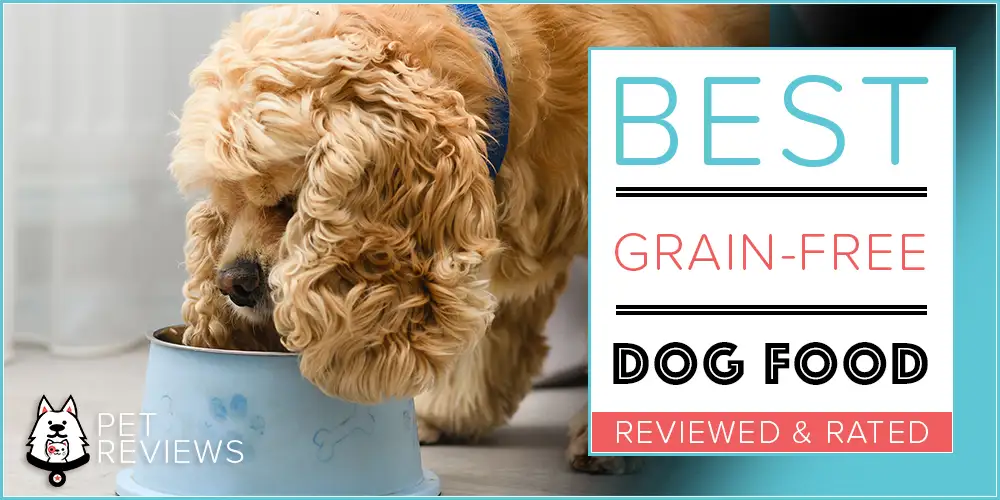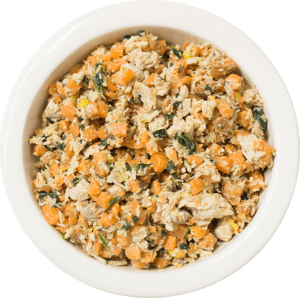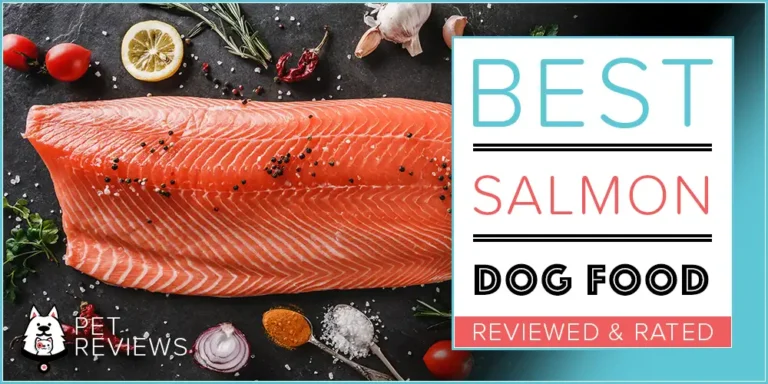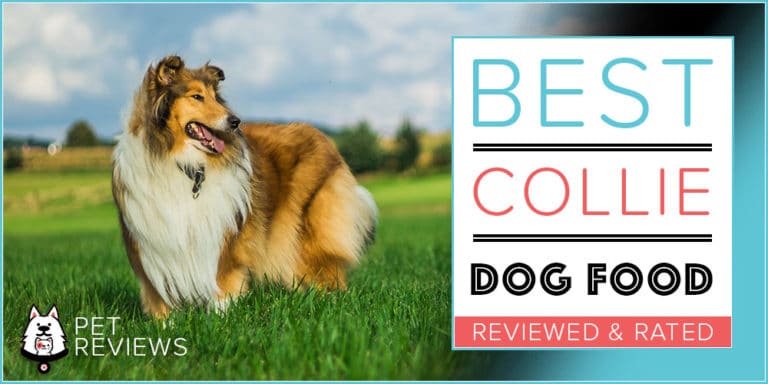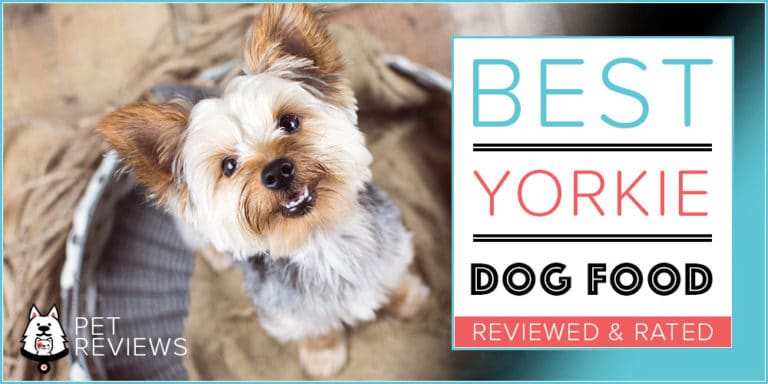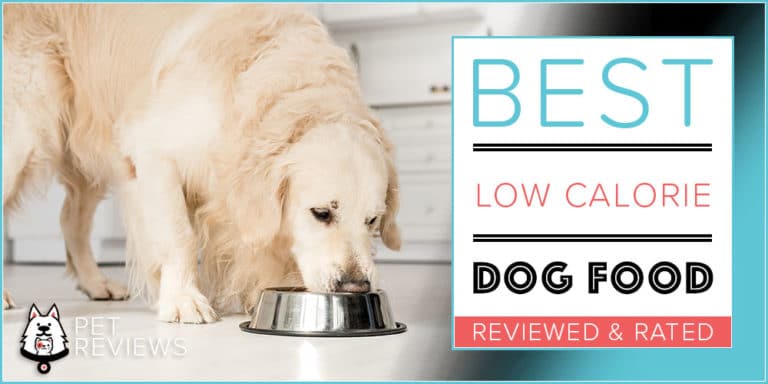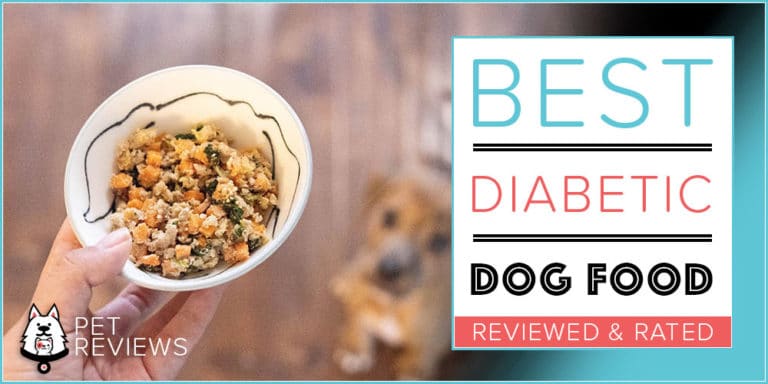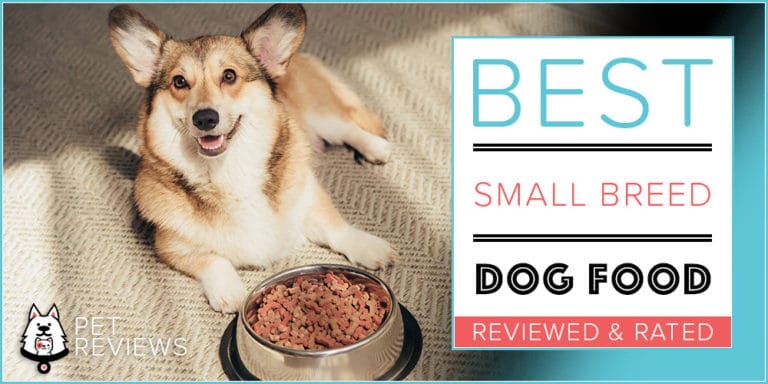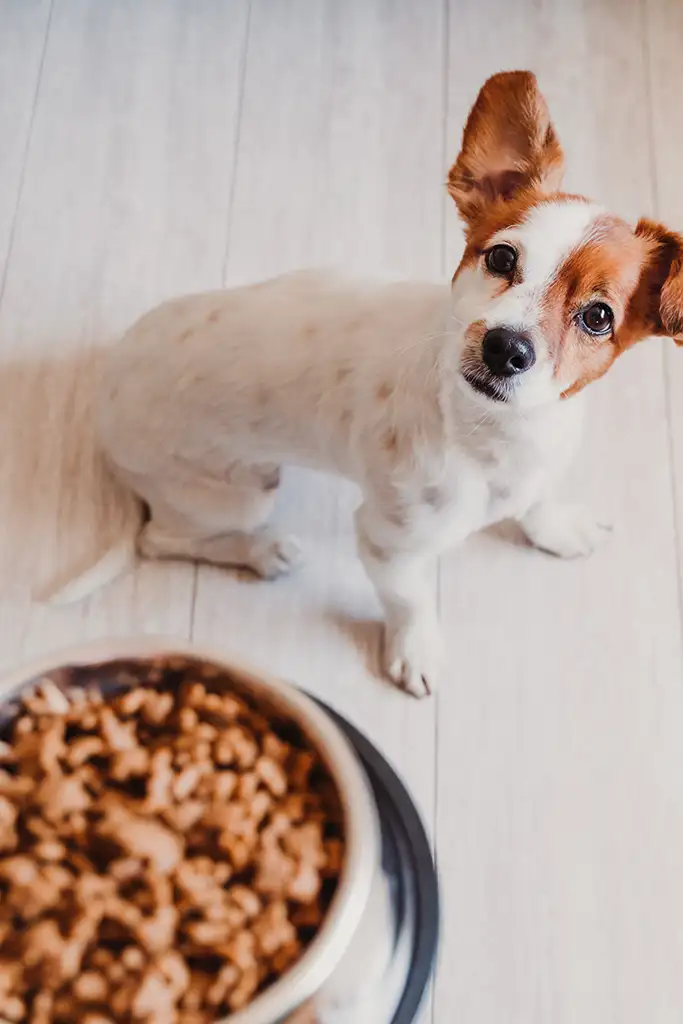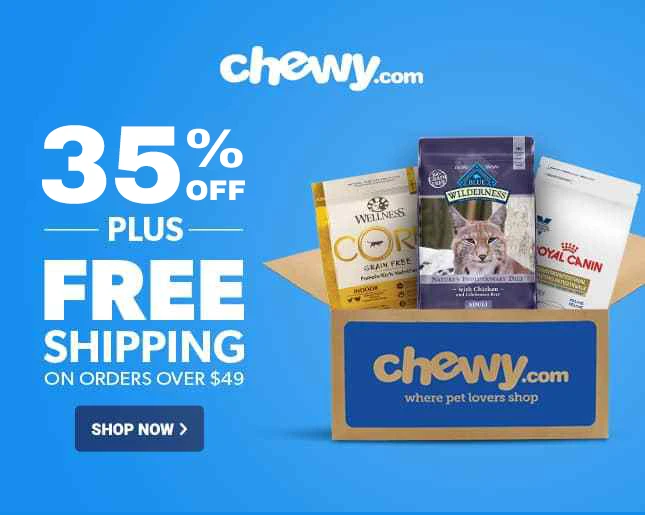10 Best Grain Free Dog Foods with our Most Affordable Pick
Quick Guide
- What Is The Best Grain Free Dog Food?
- What Do You Need to Know About Grain-Free Dog Food?
- Understanding Dilated Cardiomyopathy in Dogs
- What to Look for in a Grain-Free Dog Food
- The 10 Best Grain-Free Dog Foods
- NomNomNow Porkalicious Potluck
- Taste of the Wild High Prairie Canine Grain-Free Dog Food
- American Journey Grain-Free Salmon & Sweet Potato Recipe
- Blue Buffalo Wilderness Chicken Recipe Grain-Free Puppy Food
- Wellness CORE Grain-Free Senior Deboned Turkey Recipe
- Nutro Limited Ingredient Diet Grain-Free Lamb & Sweet Potato Recipe
- 4 More Top-Rated Grain-Free Dog Foods
- Frequently Asked Questions
- Conclusion
Grain-free dog food is healthier than regular kibble. Or is it?
Many dog owners mistakenly believe that grain-free dog food is inherently a healthier option for their dog just because it doesn’t contain grains. In reality, grains can be a wholesome source of fiber, energy, and essential nutrients for dogs. The only problem occurs when your dog is allergic or sensitive to grains.
Most dogs are able to tolerate whole grains, but recent FDA activity has led many pet owners to panic about grain-free diets. The fact is that the FDA has received numerous reports linking grain-free diets to health problems like dilated cardiomyopathy (DCM) in dogs. What you need to remember, however, is that just because a connection between grain-free pet food and DCM exists doesn’t necessarily mean that grain-free diets are the cause. The FDA has yet to issue an official statement.
In this article, we’ll explore the subject of grain-free dog food in greater depth. We’ll provide details about the FDA’s investigation and give you our perspective on the entire situation. You’ll also see our top 10 picks for the best grain-free dog food.
What Is The Best Grain Free Dog Food?
- NomNomNow Porkalicious Potluck
- Taste of the Wild High Prairie Canine Grain-Free Dog Food – Most Popular
- American Journey Grain-Free Salmon & Sweet Potato Recipe – Most Affordable
- Blue Buffalo Wilderness Chicken Recipe Grain-Free Puppy Food
- Wellness CORE Grain-Free Senior Deboned Turkey Recipe
- Nutro Limited Ingredient Diet Grain-Free Lamb & Sweet Potato Recipe
- Nature’s Variety Instinct Raw Boost Small Breed Grain-Free Recipe with Real Chicken
- Blue Buffalo Freedom Large Breed Adult Chicken Recipe Grain-Free Dry Food
- Wellness Simple LID Grain-Free Salmon & Potato Formula
- Zignature Turkey Limited Ingredient Formula Grain-Free Dry Food
What Do You Need to Know About Grain-Free Dog Food?
Grain-free dog food is exactly what it sounds like – dog food made without grains. But what exactly does that mean? If you can’t answer this question, you’re not alone. There is a great deal of misinformation out there about grain-free diets for pets, and that’s what we want to address.
Let’s start with the FDA grain free dog food warning.
In July of 2018, the FDA began investigating consumer reports linking cases of canine dilated cardiomyopathy with certain pet foods containing peas, lentils, legumes, and potatoes as main ingredients. In their initial announcement, the FDA notes that these reports are unusual because they involve cases of DCM in dog breeds not typically prone to the disease. We’ll talk more about DCM in the next section, but for now, what you need to know is that this condition is typically inherited and is most common in large and giant breeds.
What is important to remember about this issue is that the underlying cause of DCM is unknown. What we do know is that reports of DCM linked to grain-free diets typically included the following foods as main ingredients:
- Potatoes
- Peas
- Lentils
- Other pulses
In addition to these ingredients, the protein, starch, and fiber derivatives of such may also be implicated in the connection with DCM. In most cases, the dogs included in the report had been following a grain-free diet high in these foods for a period of months to years.
In February 2024, the FDA issued an update on their grain free dog food warning and the subsequent investigation. According to this update, the FDA investigated a total of 300 reports, over 90% of which were received after the investigation was announced. These cases spanned a wide variety of breeds, not just large and giant breeds, and in cases where the dog ate a single primary diet, 90% of those cases were fed a grain-free diet containing peas and/or lentils as main ingredients.
In response to the FDA grain free dog food warning, many pet experts have published articles with their own interpretation. Nancy Kerns of the Whole Dog Journal, for example, cautions pet owners against panicking, highlighting the fact that the FDA has yet to issue an official statement and the results of their investigation said there may be a link between DCM and some grain-free diets. She encourages pet owners to do their own research and to talk to their veterinarian about their concerns.
Lisa Freeman, another pet expert, highlights that it is inaccurate to call all grain free dog food bad because there are a variety of grain-free diets. She suggests that the problem may not be just with grain-free diets, but also with dog foods from boutique companies and those that use exotic ingredients. She calls these boutique, exotic, and grain-free diets “BEG” diets.
Because there has been no conclusive scientific evidence linking grain-free dog food and cardiomyopathy, it is up to the individual dog owner to make the best choice for his dog. Keep reading to learn more about canine DCM and what to look for when shopping for grain-free dog food.
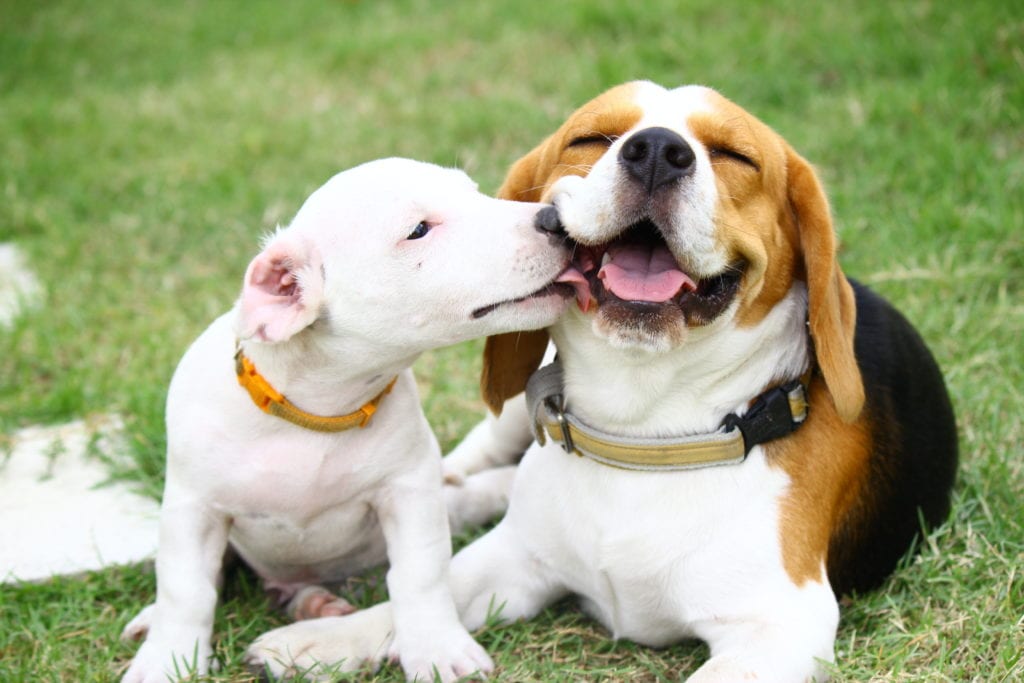
Understanding Dilated Cardiomyopathy in Dogs
With the grain-free dog food warning issued by the FDA, many dog owners are panicking. Before you determine whether grain-free food is a good or bad choice for your dog, you need to understand the risks or lack thereof.
Dilated cardiomyopathy is a condition that affects the heart muscle, resulting in an enlarged heart. When the heart becomes dilated, it makes it harder to pump, which may result in leaking heart valves and the accumulation of fluid in the chest and abdomen. In many cases, DCM eventually leads to congestive heart failure. With appropriate treatment and dietary modifications, however, non-genetic cases of DCM can sometimes be reversed when caught early enough.
Though DCM in dogs is often genetic, it affects certain breeds and breed sizes more than others. Some of the breeds most highly affected by this disease are:
- Boxers
- Great Danes
- Newfoundlands
- Irish Wolfhounds
- Saint Bernards
- Doberman Pinschers
- American Cocker Spaniels
- English Cocker Spaniels
Whether or not you feed your dog a grain-free diet, you should familiarize yourself with the most common symptoms of cardiomyopathy. Early symptoms typically include decreased energy, cough, difficulty breathing, and episodes of collapse. Many dogs with DCM also have low blood levels of the amino acid taurine, though the connection is still poorly understood. Regardless whether you feed your dog regular kibble or grain free dog food, heart disease is a fairly common health problem that you should be on the lookout for and should bring any symptoms to your vet’s attention immediately.
When it comes to grain-free dog food and cardiomyopathy, there is no conclusive evidence to show that grain-free dog food causes heart disease. The fact that a link exists should be enough to make you think twice about the best dog food for your pooch but talk to your vet before making any dietary changes.
What to Look for in a Grain-Free Dog Food
Shopping for grain-free dog food is like shopping for any other food – you need to make sure that the formula meets your dog’s basic nutritional requirements above all else. Your dog needs a protein-rich diet to support his lean muscle mass with low-to-moderate fat and calorie content, according to his activity level. He also needs certain vitamins and minerals for nutritional balance and can benefit from certain supplements like probiotics and joint-supporting glucosamine and chondroitin.
Here are some of the most important things to look for in grain-free dog food:
- High-quality animal protein. Adult dogs require a minimum of 18% protein in their diets, and puppies need at least 22%. The higher the protein content, the better, because it supports lean muscle mass. It is best from animal sources because they contain all essential amino acids.
- Healthy animal-based fats. Fat provides a concentrated source of calories for your dog as well as omega fatty acids for skin and coat support. Look for animal sources like chicken fat.
- Low-to-moderate digestible carb content. Dogs are primarily carnivorous animals, so the total carb content of your dog’s diet should be low-to-moderate and highly digestible. If your dog has trouble digesting grains, look for grain-free options like sweet potato, tapioca, or other veggies.
- Essential vitamins and minerals. Vitamins and minerals are an essential part of your dog’s diet, and as long as you choose a recipe that is AAFCO-approved, it will meet your dog’s minimum needs. Keep in mind that some minerals, chelated minerals, are more biologically valuable.
Now that you have a better idea what to look for in a grain-free dog food, you’re ready to start shopping! Keep reading to see our top 10 picks.
The 10 Best Grain-Free Dog Foods
If you’re convinced that a grain-free diet is best for your dog, there are plenty of options to choose from. The best dog food will be complete and nutritionally balanced, regardless of being grain-free or not. Make sure that a premium source of animal protein is the first ingredient with low-to-moderate carbohydrate content and moderate fat and calories. If your veterinarian recommends a formula specific to your dog’s breed size (toy, small, medium, large, or giant), then start with that before evaluating your grain-free options.
Here’s our top pick for the best grain-free dog food:
| Our 2024 Picks: Best Grain Free Dog Food | |||
NomNomNow Dog Food Delivery
|
CHECK PRICE | ||
Taste Of The Wild High Prairie Canine Grain-Free Dog Food
|
CHECK PRICE | ||
American Journey Grain-Free Salmon & Sweet Potato Recipe
|
CHECK PRICE | ||
Blue Buffalo Wilderness Chicken Recipe Grain-Free Puppy Food
|
CHECK PRICE | ||
Wellness CORE Grain-Free Senior Deboned Turkey Recipe
|
CHECK PRICE | ||
Nutro Limited Ingredient Diet Grain-Free Lamb & Sweet Potato Recipe
|
CHECK PRICE | ||
Nature’s Variety Instinct Raw Boost Small Breed Grain-Free Recipe With Real Chicken
|
CHECK PRICE | ||
Blue Buffalo Freedom Large Breed Adult Chicken Recipe Grain-Free Dry Food
|
CHECK PRICE | ||
Wellness Simple LID Grain-Free Salmon & Potato Formula
|
CHECK PRICE | ||
Zignature Turkey Limited Ingredient Formula Grain-Free Dry Food
|
CHECK PRICE | ||
NomNomNow Porkalicious Potluck
Overall Best Grain-Free Dog Food: If you want what’s best for your dog, a high-quality diet is the way to go, and fresh pet food is hard to beat. Though it is more expensive than traditional kibble, it is more affordable than raw food and offers similar nutritional benefit. NomNomNow Porkalicious Potluck is our top choice for the best grain-free dog food because it is prepared fresh and sent right to your door in perfectly portioned bags according to your dog’s calorie requirements. NomNomNow offers several grain-inclusive recipes as well, but the pork recipe is grain-free. This recipe features ground pork as the primary ingredient with potatoes, green beans, and yellow squash as the main carbohydrates. It also contains fish oil for omega fatty acids, vitamins supplements, and minerals for nutritional balance.
- Pros: Grain-free fresh food, delivered fresh to your door each month, perfectly portioned for your dog’s calorie needs, fresh vegetables, nutritionally complete and balanced
- Cons: More expensive than traditional kibble, contains potatoes as a main ingredient
Taste of the Wild High Prairie Canine Grain-Free Dog Food
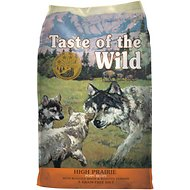
Most Popular Grain-Free Dog Food: Because there are so many options out there for dog food, it can be hard to make a decision. If you’re not sure where to start, you can always go with a popular brand like Taste of the Wild. All of Taste of the Wild’s recipes are grain-free and made with premium animal proteins. This Taste of the Wild High Prairie Canine Grain-Free Dog Food features real buffalo as the first ingredient, supplemented with lamb meal, chicken meal, roasted bison, roasted venison, and beef. It contains grain-free carbohydrates like sweet potatoes and peas with fresh fruits and vegetables to provide natural sources for key nutrients. It also contains chelated minerals for optimal nutrient absorption and probiotics for healthy digestion.
- Pros: Naturally grain-free, several premium animal proteins, highly digestible, fresh fruits and vegetables, blend of omega fatty acids, chelated minerals and probiotics, 32% protein
- Cons: Contains some peas and potatoes, contains some plant proteins (pea and potato)
American Journey Grain-Free Salmon & Sweet Potato Recipe

Most Affordable Grain-Free Dog Food: A high-quality dog doesn’t have to break the bank. American Journey is Chewy’s in-house brand and offers a wide selection of products both grain-free and grain-inclusive. We’ve chosen this American Journey Grain-Free Salmon & Sweet Potato Recipe because it features fresh salmon as the main ingredient, a rich source of protein as well as omega fatty acids. This formula lists peas and sweet potatoes as the main carbohydrates, but they fall fourth and fifth on the ingredients list. With chicken fat as the main source of fat and flaxseed, menhaden fish meal, and salmon oil later in the this, this formula provides a rich blend of omega fatty acids for healthy skin and coat. It also contains fresh fruits and vegetables, chelated minerals, and probiotic supplements for digestion.
- Pros: Fresh salmon main ingredient, digestible grain-free carbohydrates, blend of omega fatty acids, fresh fruits and vegetables, high in protein (32%), chelated minerals and probiotics
- Cons: Contains plant protein (pea protein), contains peas and chickpeas
Blue Buffalo Wilderness Chicken Recipe Grain-Free Puppy Food
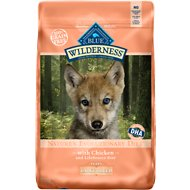
Best Grain-Free Dog Food for Puppies: Your puppy needs a high-quality, nutritious diet to grow up strong. This Blue Buffalo Wilderness Chicken Recipe Grain-Free Puppy Food is a great option because it features fresh chicken as the main ingredient and a lean source of protein. It also contains chicken meal, turkey meal, and egg for supplemental protein to support your puppy’s healthy growth and development. This recipe contains an optimal blend of calcium, phosphorus, and other essential nutrients for healthy bone growth with DHA for brain health. It is loaded with omega fatty acids in the optimal blend for skin and coat health, plus it contains Blue Buffalo’s LifeSource Bits to provide antioxidants for healthy immunity. All in all, this recipe provides a total of 36% protein, 16% fat, and 5% fiber with 423 calories per cup.
Pros: Fresh chicken first ingredient, rich in protein and fat, several supplemental proteins, rich in omega fatty acids, highly digestible, fresh fruits and vegetables, chelated minerals, probiotic supplements
Cons: Pea protein as the third ingredient
Wellness CORE Grain-Free Senior Deboned Turkey Recipe

Best Grain-Free Dog Food for Seniors: As your dog starts to get older, his body may slow down and so will his metabolism. Balanced nutrition is just as much a concern as always, but you may want to reduce the calorie and fat content of your dog’s diet to help him maintain a healthy body weight. If you’re looking for a grain-free dog food for seniors, we recommend Wellness CORE Grain-Free Senior Deboned Turkey Recipe. This formula is nutritionally balanced and rich in lean protein to support lean muscle mass. It contains only premium, all-natural ingredients with no by-products, fillers, or artificial additives. It is rich in omega fatty acids for healthy skin and coat with beneficial supplements like chelated minerals, prebiotic fiber, and probiotics. Overall, it provides 32% protein with 12% fat and 6.25% fiber at 359 calories per cup.
- Pros: Rich in protein (32%), highly digestible, moderate fat and calories, fresh fruits and vegetables, chelated mineral supplements, probiotics for digestion, rich in omega fatty acids
- Cons: Contains potatoes and peas as main ingredients
Nutro Limited Ingredient Diet Grain-Free Lamb & Sweet Potato Recipe
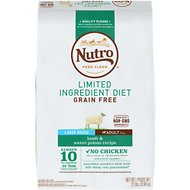
Best Grain-Free Dog Food for Sensitive Stomach: If your dog has a sensitive stomach, you may already be feeding him a grain-free diet. If he continues to show signs of sensitivity, it might actually be a food allergy in which case a limited ingredient diet could be the way to go. This Nutro Limited Ingredient Diet Grain-Free Lamb & Sweet Potato Recipe is a great option because it contains just 10 main ingredients in a protein-rich, grain-free formula. The first ingredient is pasture-fed lamb, a rich source of premium animal protein, followed by lamb meal for supplemental protein. This recipe features chickpeas, potatoes, and sweet potatoes as the primary carbohydrates with canola oil and sunflower oil for omega fatty acids. It may be higher in carbohydrates than some recipes, so keep an eye on that and be mindful of an increased risk for DCM if you have a large or giant breed dog. Always talk to your veterinarian before switching your dog’s diet.
- Pros: Deboned lamb first ingredient, just 10 main ingredients, highly digestible, blend of omega fatty acids, chelated mineral supplements, balanced protein and fat
- Cons: Could be higher in protein (20%), contains chickpeas and potatoes as main ingredients
4 More Top-Rated Grain-Free Dog Foods
If you’re not sure whether one of the foods reviewed above is the right choice for your dog, don’t worry – there are many other options out there. Here are four more top-rated options in the best grain-free dog food:
Nature’s Variety Instinct Raw Boost Small Breed Grain-Free Recipe with Real Chicken
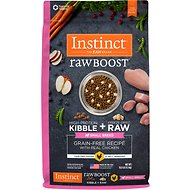
Balanced nutrition is always a priority, but small breeds have slightly different requirements than bigger dogs. For small breeds, a high concentration of calories and fat is necessary to maintain the breed’s fast metabolism. Protein is still essential, as are omega fatty acids for skin and coat. This Nature’s Variety Instinct Raw Boost Small Breed Grain-Free Recipe with Real Chicken is a great option because it delivers premium-quality nutrition in a high-protein formula that is also packed with omega fatty acids, fresh fruits and vegetables, and beneficial supplements. With chicken as the main ingredient, this recipe also contains chicken meal for a natural source of glucosamine and chondroitin. It also contains supplemental proteins and freeze-dried chicken for a boost of natural flavor and premium nutrition.
- Pros: High-protein kibble with freeze-dried raw bites, real chicken main ingredient, highly digestible recipe, rich in omega fatty acids, fresh fruits and vegetables, chelated minerals and probiotics
- Cons: Very expensive compared to traditional kibble, chickpeas as a main ingredient
Blue Buffalo Freedom Large Breed Adult Chicken Recipe Grain-Free Dry Food
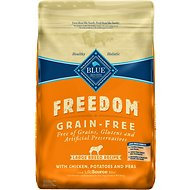
Large breeds have a slower metabolism than small breeds, but protein is still essential to maintain lean muscle mass. These dogs also need supplemental glucosamine and chondroitin in their diets for bone and joint support. We like this Blue Buffalo Freedom Large Breed Adult Chicken Recipe Grain-Free Dry Food because it is grain-free, rich in protein, and formulated specifically for large breeds. This formula features fresh chicken as the main ingredient with chicken meal to provide a natural source of joint-supporting nutrients. This formula features a rich blend of omega-3 and omega-6 fatty acids with plenty of supplemental protein, fiber, and essential nutrients. It also contains probiotics for healthy digestion.
- Pros: Formulated for large breeds, rich in lean protein, natural source of glucosamine and chondroitin, highly digestible, fresh fruits and vegetables, chelated minerals, probiotics, blend of omega fatty acids
- Cons: Potatoes and peas as main ingredients, may be too high in fiber for some dogs
Wellness Simple LID Grain-Free Salmon & Potato Formula
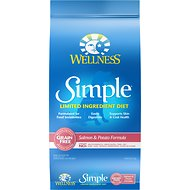
If your dog has food allergies or sensitivities, a limited ingredient diet is a good choice. This Wellness Simple LID Grain-Free Salmon & Potato Formula is a wonderful option because it comes from a line of limited ingredient diets, all made with simple, natural ingredients and no artificial additives. This recipe features fresh salmon as the main ingredient with salmon meal as a concentrated source of supplemental protein. It features potatoes and peas as digestible grain-free carbohydrates with probiotic supplements for digestive support. This recipe is rich in omega-3 and omega-6 fatty acids for healthy skin and coat, with chelated minerals for optimal nutrient absorption. Overall, it contains 25% protein and 12% fat with 446 calories per cup.
- Pros: Limited number of ingredients, real salmon first ingredient, rich blend of omega fatty acids, highly digestible, chelated minerals, probiotics for digestion, 25% protein content
- Cons: Potatoes as a main ingredient, main sources of fat are plant-based (canola oil and flaxseed)
Zignature Turkey Limited Ingredient Formula Grain-Free Dry Food
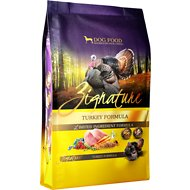
For a limited ingredient diet that delivers premium-quality nutrition, consider this Zignature Turkey Limited Ingredient Formula Grain-Free Dry Food. This formula features a handful of premium, natural ingredients include two sources of lean protein, healthy omega fatty acids, and supplemental fiber for healthy digestion. This recipe provides a total of 31% protein and 18% fat with 6% fiber at 457 calories per cup. It also contains fresh blueberries, carrots, and cranberries to provide natural sources for key vitamins, minerals, and antioxidants to help balance the vitamin supplements and chelated minerals. Overall, it is a nutritionally balanced grain-free recipe free from fillers, by-products, and artificial additives which makes it a great choice for your dog. You’ll also be glad to know that it contains a single source of animal protein novel to many dogs, so it is a good option if you’re looking for a recipe to use in an elimination diet or food trial for dog food allergies.
- Pros: Limited number of ingredients, single source of animal protein, highly digestible, rich in omega fatty acids, chelated minerals, fresh fruits and vegetables, complete and balanced
- Cons: Chickpeas and peas as main ingredients, contains plant protein (pea protein)
Frequently Asked Questions
- How much should I feed my dog? – The amount you feed your dog depends on numerous factors. First, you need to know the calorie content of the food you’ve chosen so you can adjust your dog’s portion according to his calorie needs. The easiest thing you can do is choose a recipe appropriate for your dog’s breed size and life stage then follow the feeding recommendations according to his age and body weight.
- How often should I feed my dog? –Most dogs do well with two meals per day. This being said, puppies and small breeds burn through calories at a faster rate and may do best with three or four small meals spaced evenly throughout the day. With large breeds, you need to prevent your dog from eating too much at once, so choose a large-breed formula made with larger kibbles to control the portion size or use a slow-feed bowl.
- What should I know about dog food allergies? – Dog food allergies are less common than pet food manufacturers would have you believe, but they do happen. The most common food allergens for dogs are common proteins like beef, chicken, fish, and pork as well as dairy products, corn, wheat, and soy. Dog food allergies can develop at any age, and many dogs who have them are allergic to more than one ingredient. If your dog shows signs of a food allergy, switch to a limited ingredient diet (LID) made with a novel source of protein and carbohydrate until all signs of the allergy disappear. From there, you can introduce potential allergens one at a time to find the culprit or just keep feeding your dog the LID.
- When should I switch my puppy to adult dog food? –Most veterinarians recommend keeping a puppy on puppy food until he reaches 12 months of age. What you need to remember, however, is that many puppies reach full size before 12 months and many don’t reach maturity until 18 to 24 months. A better rule of thumb to follow may be to feed your puppy a puppy diet until he reaches 80% of his adult size or when his growth starts to slow down. For small breeds, you’ll still need to feed your dog a calorie-dense diet to support his fast metabolism but, with larger breeds, the concern is preventing rapid growth that might put your dog at risk for joint problems.
- What about size-specific dog foods? –Though all dogs have the same basic nutritional requirements, there are some slight differences for different breed sizes. Toy and small breeds (under 20 pounds) have very fast metabolisms and therefore need a higher concentration of fat and calories in their diets. Large and giant breeds, on the other hand, burn calories at a slower rate, and their growth needs to be controlled in order to limit their risk for bone and joint problems. Unless your dog is in the medium range between 30 and 50 pounds, you may want to consider choosing a size-specific formula appropriate for your dog’s life stage.
Conclusion
Many dog owners worry that if they don’t feed their dog grain-free dog food, bad things will happen. While the FDA is identified a potential link between grain-free diets and canine dilated cardiomyopathy, there is no conclusive evidence as of yet, and the fact remains that grain-free dog food is not inherently healthier than traditional dog food. The thing to remember is that dogs are primarily carnivorous animals, so carbohydrates should make up a limited portion of the diet, grain-free or not.
Shopping for dog food can easily become overwhelming because there are so many options to choose from. If you’re determined to feed your dog grain-free food and don’t know where to start, consider one of the top 10 best grain-free dog foods we’ve reviewed above.

